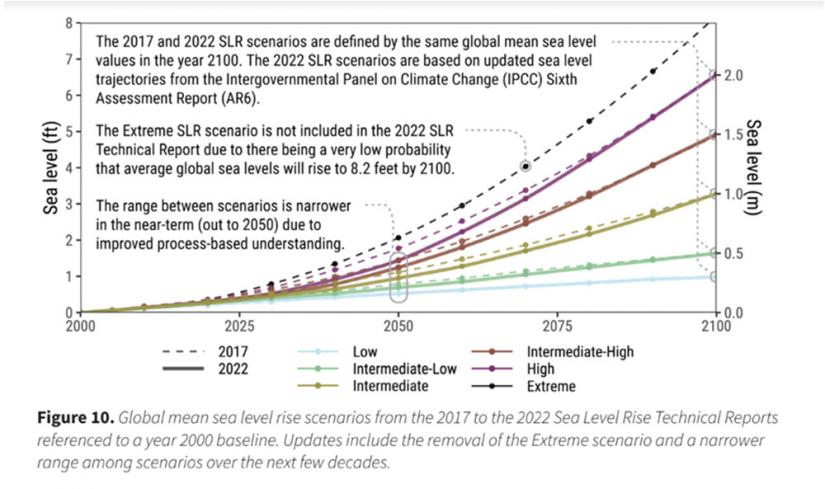As sea levels rise across the globe, preparation is critical for coastal communities — including those along the California coast — that face increased flooding, eroding beaches and threats to critical infrastructure.
Accurate, up-to-date science — and an understanding of how to apply it — are key to helping communities effectively plan for immediate and future sea level rise impacts. Today, a new national sea level rise application guide was published that will help coastal stakeholders and decision makers navigate the latest sea level rise projections and use them to better prepare their communities. The Application Guide for the 2022 Sea Level Rise Technical Report highlights key science updates in the federal agency-led 2022 Sea Level Rise Technical Report, while providing examples for how to integrate this science into community planning and adaptation approaches.
“This guide is a how-to document that helps community members figure out how to combine future scenarios with risk management approaches to maximize investments and planning for sea level rise in their region,” said Laura Engeman, coastal resilience specialist at California Sea Grant and Scripps Institution of Oceanography. “It’s designed to help no matter what stage of preparation communities are at — whether they’re just starting out or deep into adaptation planning.”
The application guide includes recommended practices for using the future scenarios outlined in the 2022 Sea Level Rise Technical Report emphasizing the importance of community engagement and understanding risk tolerance, adaptive capacity, and related coastal and climate processes such as El Niño cycles. Additionally, it provides real world examples of sea level rise adaptation planning approaches from communities across the country.
The application guide also provides numerous graphics to help illustrate the science updates detailed in the 2022 Sea Level Rise Technical Report including how variables such as land motion and ice melt adjusted the previously released 2017 sea level rise scenarios.

The guide represents significant progress toward making sea level rise science accessible, understandable and actionable for coastal communities. This is the first time this type of resource, which pulls from the expertise of both scientists and community outreach specialists, has been released to accompany the national science report.
“This was a unique effort to make sure the science in this report was getting used right out the door, and that community stakeholders were able to understand what was being presented in the report and how the sea level rise projections have changed in the last five years,” Engeman said.
The application guide was made possible through a collaboration of NOAA’s National Ocean Service, Sea Grant programs (Georgia, Florida, Mississippi/Alabama, California, Washington and Hawai'i), Mississippi State University, EcoAdapt, and the Jacques Cousteau National Estuarine Research Reserve.
Explore the application guide.
Read the NOAA National Ocean Service release.
Read the Sea Level Rise Technical Report.
About California Sea Grant
NOAA’s California Sea Grant College Program funds marine research, education and outreach throughout California. Headquartered at Scripps Institution of Oceanography at the University of California San Diego, California Sea Grant is one of 34 Sea Grant programs in the National Oceanic and Atmospheric Administration (NOAA), U.S. Department of Commerce.



